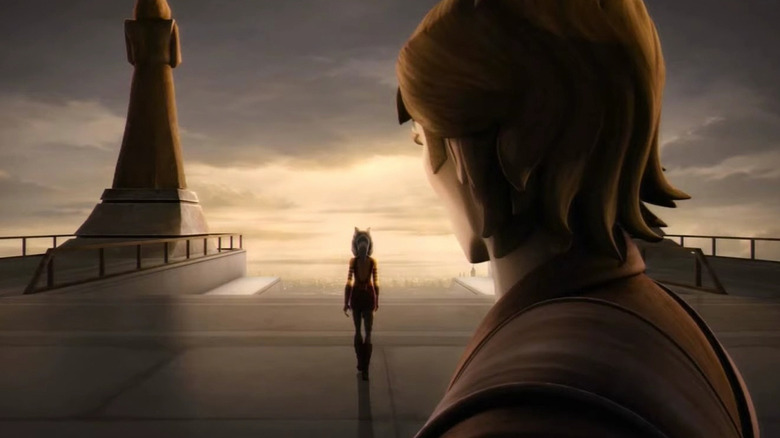What Ahsoka's White Lightsaber Really Means In Star Wars
To the casual "Star Wars" observer, the lightsaber is an iconic symbol of a longstanding franchise, and a pretty cool accessory to boot. And to be fair, that's definitely true. But lightsabers are also backed by incredibly interesting lore. While not every lightsaber fun fact is part of the current canon, lightsaber lore continues to expand as new Force-wielders are introduced to that galaxy far away.
Take Ahsoka Tano, for instance. Though she's a relatively new addition to the franchise, Ahsoka has popped up in a fair amount of "Star Wars" media — all of which supports a pretty hefty character evolution. "Star Wars" fans have essentially watched Ahsoka grow up over the years, from her days as a Jedi padawan during the Clone Wars, to her fallout with the Jedi Order, to her brief stint as a mentor in "Star Wars: Rebels" — and even her jump to live-action in "The Mandalorian." And as she's evolved, so have her weapons of choice: from the green and yellow lightsabers of "Star Wars: The Clone Wars" to the brilliant white blades she's sported ever since.
Ahsoka's transition to dual white blades is just as symbolic as it is cosmetic. White lightsabers are incredibly rare in the "Star Wars" universe. The practice of creating white blades is also steeped in the spiritual side of franchise lore. So how exactly did Ahsoka come by her lesser-used weaponry, and what does it reveal about her relationship to the Force?
When did Ahsoka get her white lightsabers?
The lightsaber is an important possession for any Force wielder. As Jedi Master Obi-Wan Kenobi emphasizes in "Star Wars: Episode II — Attack of the Clones," it's a weapon that should be as important to a Jedi as their own life. That said, not every Jedi manages to hold onto their original lightsaber for their entire lives. Things happen, especially during battles, so a few characters have been known to replace their weapons as needed.
This is definitely the case for Ahsoka, though the case of her missing lightsabers is a bit more complicated. Ahsoka's weapons — her initial green variation — were actually confiscated during the "Wrong Jedi" arc in "The Clone Wars." When Ahsoka is framed for an attack on the Jedi Temple, she's expelled from the Jedi Order, and all the perks and toys that come with it. Though her Master, Anakin Skywalker, is eventually able to clear her name, Ahsoka declines to return to the Order. From the moment she sets off on her own at the end of "The Clone Wars" season 5, Ahsoka is no longer aligned with the Jedi — but she's not exactly turning to the dark side either.
Ahsoka does a lot of soul-searching between her final appearance in "The Clone Wars" (during the series' seventh season revival on Disney+) and her reintroduction in "Rebels." It's during this time that Ahsoka begins to make peace with her future as a free agent, and sets out to build a new set of lightsabers that will reflect her newfound neutrality.
Into the light
All lightsabers — Jedi, Sith or otherwise — are powered by kyber crystals, naturally-occurring minerals that are able to channel the Force into a unique kind of energy. The crystals possess a sort of sentience, and are even able to communicate with Force-wielders. Sith-aligned warriors use this to their advantage through a practice called "bleeding," which gives every Sith lightsaber their distinctive red hue.
Bleeding a crystal is an intense procedure. Dark side wielders have to pour their feelings of hate, rage and fear into the crystal in order to bend it to their will — and there's always the chance that the crystal will somehow resist their new Sith programming. Bleeding can even damage a crystal, but the process can also be reversed by a willing Force user.
Ahsoka is able to "heal" a set of corrupted kyber crystals in the novel "Ahsoka." Though her search for a suitable crystal initially takes her to the planet Ilum, where many Jedi harvest kyber for the first time, she's eventually called to a remote moon in the Outer Rim. There, she comes face to face with an Imperial Inquisitor, the Sixth Brother, who had been hunting her for some time. Ahsoka realizes that the crystals inside the Inquisitor's lightsaber have been calling to her, and after defeating the Sixth Brother, she's able to cleanse them of the dark side. The process turns the crystals pure white, providing the base for her new weapons.
So ... why white?
Ahsoka's now-white blades are more than just an aesthetic choice for the character. According to "Star Wars: Rebels" showrunner Dave Filoni (who also created Ahsoka back in 2008), white is a clear marker for Ahsoka's neutrality moving forward. She's not aligned with the Jedi or the Sith, but she is still a disciple of the Force, which merits her reliance on lightsabers. She's still compelled to "acts of kindness," especially once she joins the fledgling Rebel Alliance at the end of the "Ahsoka" novel.
White would continue to inform Ahsoka's characterization throughout her time on "Rebels": her white cloak and staff worn in the series finale show just how much she's matured since she was first introduced in "The Clone Wars." Though she's had a rocky past, Ahsoka never stopped chasing the light — not unlike the kyber crystals she purified for her latest lightsabers. There's a reason why white also represents purity. In a way, Ahsoka is the embodiment of all that a Force-wielder should be, especially compared to the Jedi that were too blinded by the dark side during the fall of the Galactic Republic.
Will Ahsoka continue to rewrite the rules for Force-wielders in the future, especially with her own live-action series on the way? That remains to be seen, but her evolution throughout the franchise has always been exciting for "Star Wars" fans, and there's no reason why the "Ahsoka" series should be any different.



